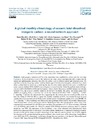Identificador persistente para citar o vincular este elemento:
https://accedacris.ulpgc.es/jspui/handle/10553/74646
| Campo DC | Valor | idioma |
|---|---|---|
| dc.contributor.author | Broullón, Daniel | en_US |
| dc.contributor.author | Pérez, Fiz F. | en_US |
| dc.contributor.author | Velo, Anton | en_US |
| dc.contributor.author | Hoppema, Mario | en_US |
| dc.contributor.author | Olsen, Are | en_US |
| dc.contributor.author | Takahashi, Taro | en_US |
| dc.contributor.author | Key, Robert M. | en_US |
| dc.contributor.author | Tanhua, Toste | en_US |
| dc.contributor.author | Magdalena Santana-Casiano, J. | en_US |
| dc.contributor.author | Kozyr, Alex | en_US |
| dc.date.accessioned | 2020-10-05T08:32:28Z | - |
| dc.date.available | 2020-10-05T08:32:28Z | - |
| dc.date.issued | 2020 | en_US |
| dc.identifier.issn | 1866-3508 | en_US |
| dc.identifier.other | Scopus | - |
| dc.identifier.uri | https://accedacris.ulpgc.es/handle/10553/74646 | - |
| dc.description.abstract | Anthropogenic emissions of CO2 to the atmosphere have modified the carbon cycle for more than 2 centuries. As the ocean stores most of the carbon on our planet, there is an important task in unraveling the natural and anthropogenic processes that drive the carbon cycle at different spatial and temporal scales. We contribute to this by designing a global monthly climatology of total dissolved inorganic carbon (TCO2), which offers a robust basis in carbon cycle modeling but also for other studies related to this cycle. A feedforward neural network (dubbed NNGv2LDEO) was configured to extract from the Global Ocean Data Analysis Project version 2.2019 (GLODAPv2.2019) and the Lamont-Doherty Earth Observatory (LDEO) datasets the relations between TCO2 and a set of variables related to the former’s variability. The global root mean square error (RMSE) of mapping TCO2 is relatively low for the two datasets (GLODAPv2.2019: 7.2 μmolkg1; LDEO: 11.4 μmolkg1) and also for independent data, suggesting that the network does not overfit possible errors in data. The ability of NNGv2LDEO to capture the monthly variability of TCO2 was testified through the good reproduction of the seasonal cycle in 10 time series stations spread over different regions of the ocean (RMSE: 3.6 to 13.2 μmolkg1). The climatology was obtained by passing through NNGv2LDEO the monthly climatological fields of temperature, salinity, and oxygen from the World Ocean Atlas 2013 and phosphate, nitrate, and silicate computed from a neural network fed with the previous fields. The resolution is 11 in the horizontal, 102 depth levels (0-5500 m), and monthly (0-1500 m) to annual (1550-5500 m) temporal resolution, and it is centered around the year 1995. The uncertainty of the climatology is low when compared with climatological values derived from measured TCO2 in the largest time series stations. Furthermore, a computed climatology of partial pressure of CO2 (pCO2) from a previous climatology of total alkalinity and the present one of TCO2 supports the robustness of this product through the good correlation with a widely used pCO2 climatology (Landschützer et al., 2017). Our TCO2 climatology is distributed through the data repository of the Spanish National Research Council (CSIC; https://doi.org/10.20350/digitalCSIC/10551, Broullón et al., 2020). | en_US |
| dc.language | eng | en_US |
| dc.relation | Optimizing and Enhancing the Integrated Atlantic Ocean Observing System | en_US |
| dc.relation.ispartof | Earth System Science Data | en_US |
| dc.source | Earth System Science Data [ISSN 1866-3508], v. 12 (3), p. 1725-1743, (Agosto 2020) | en_US |
| dc.subject | 251002 Oceanografía química | en_US |
| dc.subject.other | Carbon cycle | en_US |
| dc.title | A global monthly climatology of oceanic total dissolved inorganic carbon: A neural network approach | en_US |
| dc.type | info:eu-repo/semantics/Article | en_US |
| dc.type | Article | en_US |
| dc.identifier.doi | 10.5194/essd-12-1725-2020 | en_US |
| dc.identifier.scopus | 85091493952 | - |
| dc.contributor.authorscopusid | 57211473584 | - |
| dc.contributor.authorscopusid | 56598611300 | - |
| dc.contributor.authorscopusid | 36007807200 | - |
| dc.contributor.authorscopusid | 35401714600 | - |
| dc.contributor.authorscopusid | 7202795681 | - |
| dc.contributor.authorscopusid | 7406455112 | - |
| dc.contributor.authorscopusid | 8987364700 | - |
| dc.contributor.authorscopusid | 16029608000 | - |
| dc.contributor.authorscopusid | 57219161910 | - |
| dc.contributor.authorscopusid | 6602937578 | - |
| dc.identifier.eissn | 1866-3516 | - |
| dc.description.lastpage | 1743 | en_US |
| dc.identifier.issue | 3 | - |
| dc.description.firstpage | 1725 | en_US |
| dc.relation.volume | 12 | en_US |
| dc.investigacion | Ciencias | en_US |
| dc.type2 | Artículo | en_US |
| dc.description.numberofpages | 9 | en_US |
| dc.utils.revision | Sí | en_US |
| dc.date.coverdate | Agosto 2020 | en_US |
| dc.identifier.ulpgc | Sí | es |
| dc.description.sjr | 4,066 | |
| dc.description.jcr | 11,333 | |
| dc.description.sjrq | Q1 | |
| dc.description.jcrq | Q1 | |
| dc.description.scie | SCIE | |
| item.fulltext | Con texto completo | - |
| item.grantfulltext | open | - |
| crisitem.author.dept | GIR IOCAG: Química Marina | - |
| crisitem.author.dept | IU de Oceanografía y Cambio Global | - |
| crisitem.author.dept | Departamento de Química | - |
| crisitem.author.orcid | 0000-0002-7930-7683 | - |
| crisitem.author.parentorg | IU de Oceanografía y Cambio Global | - |
| crisitem.author.fullName | Santana Casiano, Juana Magdalena | - |
| crisitem.project.principalinvestigator | González Dávila, Melchor | - |
| Colección: | Artículos | |
Citas SCOPUSTM
36
actualizado el 08-jun-2025
Citas de WEB OF SCIENCETM
Citations
32
actualizado el 08-jun-2025
Visitas
167
actualizado el 12-jul-2025
Descargas
165
actualizado el 12-jul-2025
Google ScholarTM
Verifica
Altmetric
Comparte
Exporta metadatos
Los elementos en ULPGC accedaCRIS están protegidos por derechos de autor con todos los derechos reservados, a menos que se indique lo contrario.
